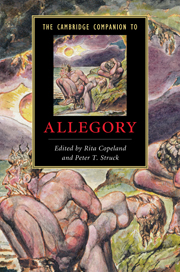Book contents
- Frontmatter
- Introduction
- Part I: Ancient foundations
- Part II: Philosophy, theology, and poetry 200 to 1200
- Part III: Literary allegory: philosophy and figuration
- 8 Allegory in the Roman de la Rose
- 9 Dante and allegory
- 10 Medieval secular allegory: French and English
- 11 Medieval religious allegory: French and English
- 12 Renaissance allegory from Petrarch to Spenser
- 13 Protestant allegory
- 14 Allegorical drama
- Part IV: The fall and rise of allegory
- Further reading
- Index
10 - Medieval secular allegory: French and English
from Part III: - Literary allegory: philosophy and figuration
Published online by Cambridge University Press: 28 January 2011
- Frontmatter
- Introduction
- Part I: Ancient foundations
- Part II: Philosophy, theology, and poetry 200 to 1200
- Part III: Literary allegory: philosophy and figuration
- 8 Allegory in the Roman de la Rose
- 9 Dante and allegory
- 10 Medieval secular allegory: French and English
- 11 Medieval religious allegory: French and English
- 12 Renaissance allegory from Petrarch to Spenser
- 13 Protestant allegory
- 14 Allegorical drama
- Part IV: The fall and rise of allegory
- Further reading
- Index
Summary
Behind the Roman de la Rose lies a tradition of philosophical allegory. The Rose in turn inspired a tradition of secular allegory, in narrative and lyric forms, across Europe. This essay will focus on French poetry of the fourteenth and early fifteenth centuries, and the extension of these poetic conventions into England. Both Guillaume de Lorris and Jean de Meun, the authors of the two parts of the Rose, experiment with the claims of philosophical truth in poetry. In their hands, vernacular poetry rose to new heights of ambition: the Rose combines classical myth with philosophical reflection, dream vision with allegorical interpretation, and erotic story with cosmological themes. Their experiments provoked innovative responses in the vernacular secular allegory produced for the aristocratic milieus of France and England. One key element that distinguishes this new vernacular tradition from earlier Latin allegory is the role of its singular first-person voice. In the Roman de la Rose and the allegories that followed it, this voice is identified with the historical writer, not only narrating as writer but acting as a character, participating in the drama that structures the narrative. While these writers are interested in the experience of love and desire, they increasingly focus on love for its relation to artistic production or as a pretext for evaluating other forms of worldly or spiritual wisdom, as an opening for ethical, philosophical, or political debate. Not only the beginning of love but its ending, through age or loss of the beloved, becomes a subject for figuration.
- Type
- Chapter
- Information
- The Cambridge Companion to Allegory , pp. 136 - 147Publisher: Cambridge University PressPrint publication year: 2010



